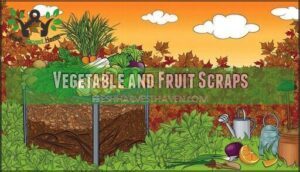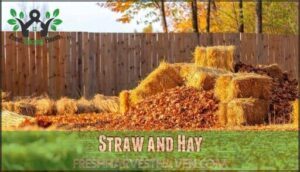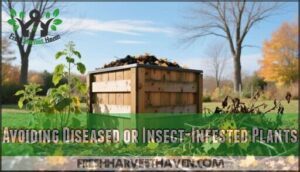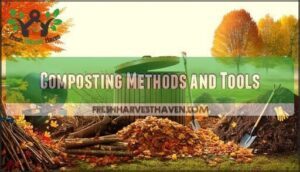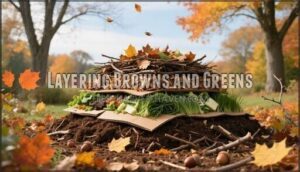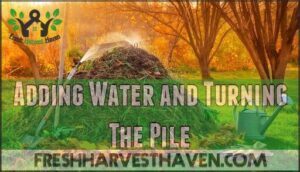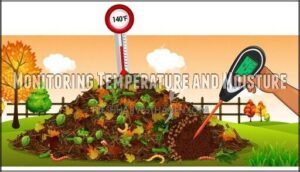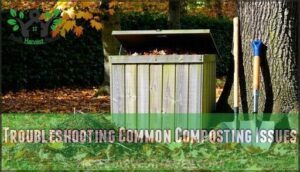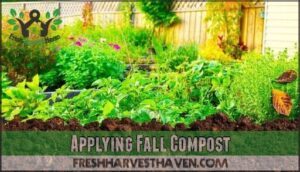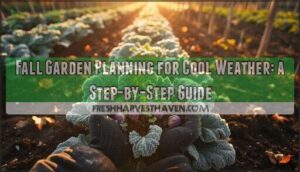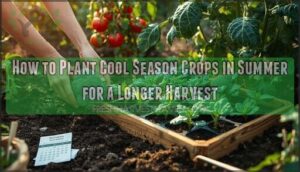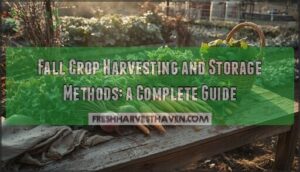This site is supported by our readers. We may earn a commission, at no cost to you, if you purchase through links.

Collect fallen leaves, grass clippings, and kitchen scraps to create nutrient-rich soil amendments.
Layer browns and greens in a 3:1 ratio, maintaining 40-60% moisture.
Turn your pile weekly and monitor temperature with a compost thermometer.
You’ll transform yard waste into garden gold while cutting fertilizer costs and reducing landfill burden.
Properly balanced compost enhances soil structure, boosts beneficial organisms, and improves water retention.
The secret lies in understanding which materials to avoid and mastering the carbon-nitrogen balance that makes decomposition thrive.
Table Of Contents
- Key Takeaways
- Benefits of Fall Composting
- Choosing Compost Materials
- Composting Methods and Tools
- Creating a Fall Compost Pile
- Applying Fall Compost
- Frequently Asked Questions (FAQs)
- Should you compost in the fall?
- How do you keep compost from freezing?
- When should you start a compost pile?
- When should you start a compost heap?
- Can fall leaves be composted?
- When should you put compost in your garden?
- Should you put compost on your garden in the fall?
- When is the best time for composting?
- How often should you turn your compost?
- What makes a good compost?
- Conclusion
Key Takeaways
- You’ll transform autumn leaves and kitchen scraps into nutrient-rich soil by maintaining a 3:1 ratio of brown to green materials with proper moisture levels
- You can save money on fertilizers while reducing landfill waste by composting your yard debris into valuable soil amendments that boost plant health naturally
- You’ll need to turn your compost pile weekly and monitor temperature (130-160°F) to ensure proper decomposition and prevent odors or pest problems
- You should apply your finished compost in fall or early spring by spreading 2-3 inches on garden beds to improve soil structure, water retention, and plant resilience
Benefits of Fall Composting
Fall composting turns your yard’s autumn bounty into garden gold while cutting waste and saving money on fertilizers.
You’ll create nutrient-rich soil amendments that boost plant health and protect against erosion when spring arrives.
Reducing Waste and Saving Money
Fall composting turns your yard waste into garden gold instead of landfill burden.
You’ll slash fertilizer costs by creating nutrient-rich compost from free materials like leaves and grass clippings.
This waste reduction strategy diverts organic matter from landfills while delivering significant cost savings.
Your homemade compost provides exceptional value, reducing dependency on expensive store-bought amendments for healthier soil naturally.
Improving Soil Fertility and Structure
Compost transforms your garden’s foundation by boosting soil fertility and creating nutrient-rich soil that plants crave.
Fall composting adds organic matter that improves water retention, helping roots access moisture during dry spells.
This soil amendment increases nutrient availability while encouraging beneficial soil organisms to thrive.
Enhanced root development follows as your compost creates loose, workable earth that roots penetrate easily, supporting stronger plant growth and natural erosion control.
Enhancing Ecosystem Restoration
When you build up disturbed garden areas, compost biodiversity works like nature’s reset button.
Your autumn leaves and organic matter create habitat creation opportunities for wildlife while supporting carbon sequestration in depleted soils.
This soil remediation process helps restore damaged landscapes after construction or environmental stress.
Fall garden composting transforms your yard waste into powerful soil enrichment tools that support pollinator support networks and nutrient recycling systems naturally.
Composting can also reduce waste disposal costs.
Increasing Beneficial Soil Organisms
Your well-managed compost pile becomes a bustling hub for compost microbes and beneficial organisms that transform your garden ecosystem.
These tiny workers create a thriving soil foodweb, breaking down organic matter through natural aeration processes.
Earthworm activity increases dramatically, while mycorrhizal fungi form partnerships with plant roots, creating a nutrient recycling system that enriches your soil naturally.
This system supports beneficial microbes that boost plant health and garden productivity year-round, resulting in a healthier and more thriving garden ecosystem.
Choosing Compost Materials
Success isn’t just about gathering the right materials for your compost pile—it’s about choosing them wisely.
You’ll want to focus on fallen leaves, grass clippings, kitchen scraps, and clean organic matter while avoiding anything diseased or pest-infested that could harm your future garden.
Fallen Leaves and Grass Clippings
Your fall garden benefits most when you shred fallen leaves before composting.
Leaf shredding speeds decomposition and creates better compost volume.
Mix these brown materials with grass clippings using proper grass layering techniques.
Maintain a 3:1 brown/green ratio for ideal decomposition speed.
This combination transforms garden waste into nutrient-rich soil amendment for next season’s growing success.
Fall composting offers an eco-friendly waste management solution through eco-friendly waste management, which is a key part of successful garden management.
Vegetable and Fruit Scraps
Your kitchen scraps and fruit scraps are valuable compost ingredients that add nitrogen and moisture to your pile.
Vegetable waste like potato peels and carrot tops work great. Don’t worry about citrus composting or onion concerns—these traditional taboos aren’t real problems with proper scrap preparation.
Just balance volume to avoid attracting pests. Keep organic waste portions smaller than your brown materials for best results.
Straw and Hay
Straw and hay serve as excellent carbon-rich materials for your fall composting guide. Understanding hay vs straw helps you make better choices for garden composting.
Straw decomposes slowly, making it perfect for adding structure and preventing compaction in your compost pile.
- Golden straw bales break down into fluffy brown matter
- Sourcing straw from local farms guarantees chemical-free compost ingredients
- Using straw mulch creates air pockets for proper decomposition
Avoiding Diseased or Insect-Infested Plants
Looking beyond safe materials like straw, you’ll need visual inspection skills for your garden composting success.
Diseased plants harbor pathogens that survive normal composting temperatures, spreading fungal infections through your finished compost.
Pest eggs and larvae withstand moderate heat, creating future infestations, and weed seeds germinate when temperatures don’t reach safe levels above 131°F.
Skip any plant showing disease symptoms, insect damage, or seed heads to protect your composting guide efforts and ensure garden composting success.
Composting Methods and Tools
You’ll need the right composting method and tools to turn your fall yard waste into nutrient-rich soil.
Whether you choose an enclosed bin, open pile, or tumbling system, each approach has specific benefits that can speed up decomposition and make maintenance easier.
Enclosed Bins and Open Piles
When choosing between composting methods, you’ll face a classic trade-off. Compost bins offer clear bin advantages like pest control and aesthetic appeal, making them perfect for smaller yards with space requirements.
However, compost piles provide easier access and better airflow despite pile disadvantages like potential odors and visual concerns.
To guarantee successful decomposition, consider using alfalfa meal fertilizer to boost microbial activity. Consider your neighborhood’s aesthetic concerns and available space when selecting your preferred composting method for fall composting steps.
Tumbling Bins and Aeration
Accelerate your compost creation with tumbling bins that cut decomposition time by up to 50%.
These enclosed systems make turning effortless—just rotate 2-3 times weekly instead of laboring with pitchforks.
The continuous aeration boosts microbial activity by 30%, while sealed designs eliminate 70-90% of odors and pest problems.
Consider browsing options for durable compost tumblers.
Choose sturdy bin materials or build DIY tumblers for faster, cleaner composting results.
Maintaining Moisture and Carbon Balance
Your compost pile’s success hinges on achieving ideal moisture levels between 40-60%, like a wrung-out sponge.
Balance carbon-rich materials such as fallen leaves with nitrogen-rich materials like grass clippings using a 25:1 carbon-to-nitrogen ratio.
Regular aeration needs through weekly turning guarantees proper decomposition rate while preventing anaerobic conditions.
Essential moisture control and carbon balance steps:
- Test moisture weekly – squeeze a handful; it should feel damp but not dripping
- Layer carbon sources – add dry leaves, straw, or shredded paper when pile gets soggy
- Monitor nitrogen importance – kitchen scraps and fresh clippings boost activity when pile slows
- Adjust green-to-brown ratio – aim for 3 parts browns to 1 part greens for superior results
- Cover during heavy rains – prevent nutrient leaching and maintain proper moisture levels
Using Compost Thermometers and Guides
Temperature monitoring helps you track your composting process accurately.
A compost thermometer measures internal heat, showing when decomposition peaks between 130-160°F.
Digital thermometers offer precise readings, while dial versions provide reliable backup options.
You can find a suitable compost thermometer online.
| Temperature Range | Composting Process | Action Needed |
|---|---|---|
| Below 90°F | Inactive pile | Add greens, turn pile |
| 90-130°F | Slow decomposition | Monitor moisture levels |
| 130-160°F | Active breakdown | Perfect range, maintain |
| 160-180°F | Too hot | Add browns, increase turning |
| Above 180°F | Overheating risk | Stop turning, add water |
Check temperatures daily during active phases.
Insert the thermometer 12-18 inches deep into different pile sections for accurate readings.
This helps in maintaining the perfect range and ensuring the composting process is efficient and reliable.
Creating a Fall Compost Pile
Now that you’ve gathered your materials and chosen your composting method, it’s time to build your fall compost pile using proper layering techniques.
Start with a base layer of coarse brown materials like twigs or straw to guarantee good drainage and airflow from the bottom up, which is essential for a successful compost pile.
Layering Browns and Greens
Start your compost pile with a foundation layer of coarse brown materials like small twigs or shredded cardboard.
Build alternating layers using three parts carbon sources to one part green materials.
This green-to-brown ratio creates ideal nitrogen balance for faster decomposition speed.
Mix fall yard cleanup debris like leaves with kitchen scraps, and these layering techniques guarantee proper composting tips success throughout your yard debris transformation.
Adding Water and Turning The Pile
Proper moisture balance and regular turning transform your pile into a decomposition powerhouse. Your compost needs consistent moisture like a wrung-out sponge—not soggy, not bone dry.
Here’s your turning schedule for ideal aeration frequency:
- Week 1-2: Turn every 3-4 days using a pitchfork or compost turner
- Week 3-6: Turn weekly as pile temperature stabilizes
- Week 7+: Turn every 2 weeks until finished
Watch for overwatering signs like foul odors or slimy texture, which indicate poor aeration and excess moisture. Composting can also help with eco-friendly waste management.
Monitoring Temperature and Moisture
Keep your compost pile at the ideal temperature of 120-160°F for active decomposition.
Check moisture levels regularly—your pile should feel like a damp sponge. Accurate readings require a reliable temperature gauge.
Monitor these key indicators to maintain healthy compost pile maintenance and guarantee proper aeration impact throughout the season.
| Temperature Range | Moisture Level | Action Needed |
|---|---|---|
| 120-160°F | Damp sponge feel | Perfect balance |
| Below 100°F | Too dry | Add water, turn pile |
| Above 170°F | Too wet | Add browns, increase aeration |
Troubleshooting Common Composting Issues
Even experienced composters face challenges during fall. Odor Problems signal too much moisture or insufficient aeration—add browns and turn weekly.
Slow Decomposition happens when piles lack nitrogen or proper surface area; shred materials and balance greens.
Pest Control requires covered bins and avoiding meat scraps.
Temperature Issues and Moisture Imbalance resolve through regular turning and strategic covering during heavy rains.
Applying Fall Compost
Once your compost has finished decomposing, you’ll have rich, dark soil amendment ready to transform your garden beds and boost plant health.
Applying this nutrient-packed material correctly guarantees maximum benefits for your soil structure, water retention, and plant growth throughout the growing season, which can lead to a significant improvement in plant health.
Using Compost in Garden Beds
Beyond simply dumping your finished compost onto garden beds, strategic application transforms your soil into a thriving foundation.
You’ll want to spread a two-to-three-inch layer across your beds, then gently work it into the top six inches of existing soil.
Here’s how compost application delivers garden transformation:
- Soil Amendment – Your homemade compost acts as nature’s multivitamin, enriching depleted garden soil with essential organic matter
- Water Retention – Compost-enriched beds hold moisture like a sponge, reducing your watering duties while keeping plants hydrated
- Nutrient Delivery – Slow-release nutrition feeds your plants throughout the growing season without chemical fertilizers
- Pest Resistance – Healthy soil creates stronger plants that naturally ward off common garden pests and diseases
This soil health investment pays dividends through improved plant health and garden soil improvement that lasts for years.
Reducing Soil Erosion and Water Runoff
Your fall compost acts as nature’s armor against soil erosion.
When you spread compost on garden beds, it reduces runoff by 50% and cuts sediment loss by up to 99%.
The organic matter binds soil particles together, creating a stable structure that resists water displacement.
This improved soil conservation means better water filtration and runoff management for your garden’s long-term health.
Effective soil care practices are essential for maintaining a healthy and productive garden ecosystem.
Improving Plant Growth and Resilience
Your fall compost creates nutrient-rich soil that transforms plant health dramatically.
Fall compost transforms your garden into a thriving ecosystem where plants flourish naturally.
Compost nutrients fuel stronger root development while improving water retention around plant bases.
The decomposition process produces beneficial microorganisms that boost disease resistance naturally.
Enhanced soil health means your plants bounce back faster from stress, drought, and seasonal changes.
- Tomato plants develop deeper root systems in compost-enriched beds, anchoring against strong winds
- Perennials emerge earlier in spring with vibrant foliage when surrounded by rich, dark compost
- Garden vegetables resist common fungal diseases better in well-composted soil
- Flower beds maintain moisture longer during dry spells, reducing your watering schedule, which improves overall plant health and requires less water retention effort, leading to stronger root development.
Storing Compost for Future Use
Proper compost storage preserves your hard work through winter months.
You’ll need compost container types like bins or covered piles for winterizing compost storage.
Maintaining compost quality requires protection from rain and freezing temperatures.
Compost storage duration can extend several months when properly managed.
Mature compost stays viable longer than fresh material.
Check compost readiness by examining texture and smell before using stored compost in spring gardens, ensuring the compost is ready for use with the right smell.
Frequently Asked Questions (FAQs)
Should you compost in the fall?
Like turning autumn’s golden bounty into garden gold, you should absolutely compost in fall. Cool weather, abundant leaves, and natural carbon-nitrogen balance create perfect conditions for nutrient-rich spring compost.
How do you keep compost from freezing?
Move your pile to a sheltered spot near buildings or under trees.
Insulate with extra browns like leaves or straw.
Cover with tarps to trap heat and maintain moisture levels effectively.
When should you start a compost pile?
Sarah decided to start composting in early spring when her vegetable garden produced its first scraps.
You should start a compost pile anytime you have organic materials available—spring through fall works best for active decomposition and management.
When should you start a compost heap?
You can start your compost heap anytime, but early fall’s the sweet spot. Cool weather and abundant leaves create perfect conditions for decomposition that’ll be ready by spring planting season.
Can fall leaves be composted?
Fallen leaves decompose 40% faster when shredded first.
You can absolutely compost fall leaves – they’re perfect "brown" carbon-rich material.
Mix three parts leaves with one part "green" nitrogen sources like grass clippings for ideal decomposition.
When should you put compost in your garden?
Apply compost to your garden in fall after harvesting, or early spring before planting.
Fall application gives nutrients time to integrate into soil over winter, preparing beds for next season’s growth.
Should you put compost on your garden in the fall?
Timing couldn’t be better! You should absolutely put compost on your garden in fall. It enriches soil during winter, reduces erosion, and gives plants a nutrient boost for spring growth.
When is the best time for composting?
You can compost year-round, but fall’s the sweet spot. Cool weather slows decomposition perfectly, while abundant leaves and garden debris give you ideal carbon-rich materials to balance your pile naturally.
How often should you turn your compost?
You should turn your compost pile every week to keep it properly aerated and mixed. Regular turning speeds up decomposition and prevents smelly anaerobic conditions from developing.
What makes a good compost?
Picture your compost as a living community that needs balance to thrive.
You’ll create excellent compost by mixing three parts carbon-rich browns (leaves, paper) with one part nitrogen-rich greens (scraps, grass clippings).
Maintaining proper moisture, and turning regularly is also crucial for the composting process.
Conclusion
Why settle for expensive fertilizers when nature provides everything you need?
This fall garden composting guide shows you can create rich soil amendments from autumn’s abundant materials.
Start your compost pile today using the 3:1 brown-to-green ratio, maintain proper moisture levels, and turn weekly.
You’ll reduce waste, save money, and boost your garden’s health.
Your plants will thank you next growing season with stronger growth and better yields.
- https://www.sciencedirect.com/science/article/pii/S0301479720301444
- https://mcgillcompost.com/wp-content/uploads/2022/01/Compost-as-Used-For-Erosion-Control-University-of-GA-paper.pdf
- https://www.canr.msu.edu/news/compost_increases_the_water_holding_capacity_of_droughty_soils
- https://veransa.com/erosion-control-water-retention-overlooked-benefits-compost/
- https://www.filtrexx.com/application/files/1014/5927/9916/109-2005-JSWC-Compost-EC-Blankets-Berms-Hydroseed-Silt-Fence.pdf


